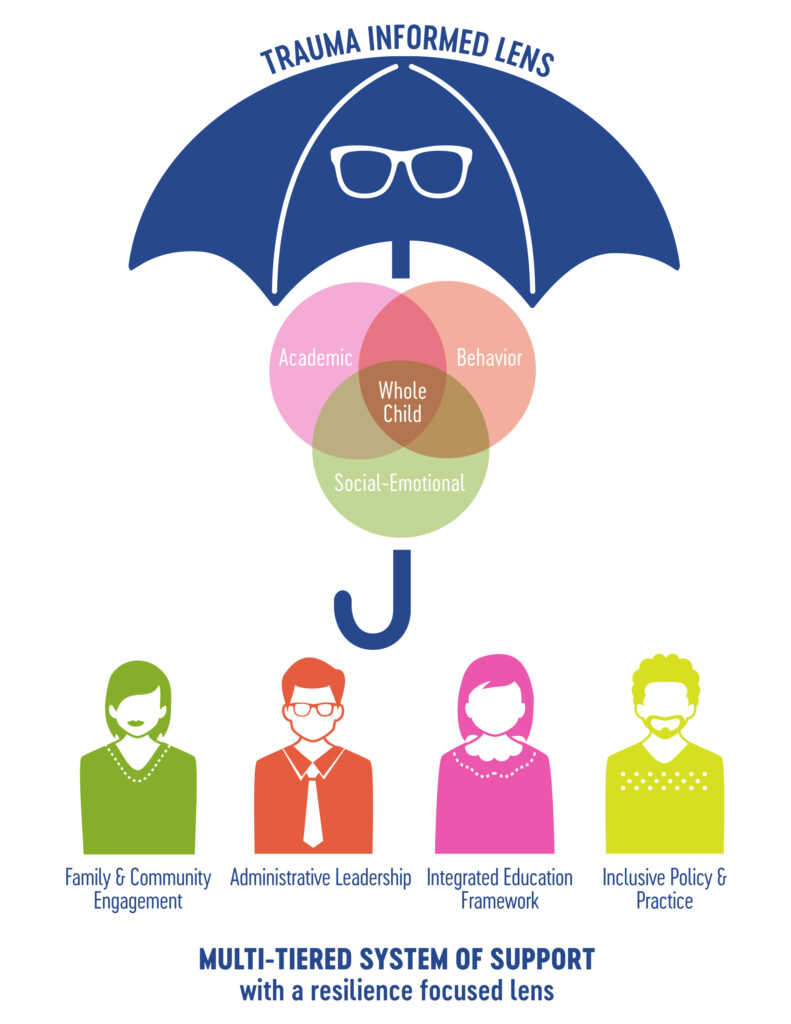 Educational leaders and teachers, you are the heartbeat of our schools, the guiding lights on our students’ educational journeys. Your dedication and passion lay the groundwork for a transformative vision: schools where every student feels cherished, understood, and empowered to thrive. Let’s embark on this inspiring journey together to create support systems that are research- and evidence-based, as well as trauma-informed.
Educational leaders and teachers, you are the heartbeat of our schools, the guiding lights on our students’ educational journeys. Your dedication and passion lay the groundwork for a transformative vision: schools where every student feels cherished, understood, and empowered to thrive. Let’s embark on this inspiring journey together to create support systems that are research- and evidence-based, as well as trauma-informed.
Foundations of a Trauma-Responsive & Resilience-Focused Approach
At the heart of our journey lies the Multi-Tiered System of Support (MTSS)—a framework that serves as the backbone of inclusive, effective, and proactive systems of support. But it’s not just about structures; it’s about mindset—a resilience-focused mindset that sees challenges as opportunities for growth and connection while approaching every experience of each day with a sense of curiosity.
Inspired by Starr Commonwealth’s Circle of Courage model, we embrace principles of belonging, mastery, independence, and generosity. We recognize behavior as communication and strive to create environments where every student feels seen, heard, and valued. Only when we understand the critical nature of meeting students’ physical and emotional needs as a priority can we unlock the key to their brains and hearts.
Within our universal systems approach and through a Restorative Approach to discipline, we prioritize restoration over retribution, fostering a sense of belonging and understanding between school and student. It’s about building bridges, not walls, and seeing discipline as an opportunity for growth and connection rather than punishment.

Universal Strategies for All Students
In our quest to create safe learning havens for all students, our first endeavor is Tier 1, creating universal access to student support academically, socially, and emotionally. Where strategies like Reset Rooms and Calm Down Corners create supportive spaces for emotional regulation for every student when they need it. These spaces, infused with the wisdom of the Circle of Courage, allow students to learn, grow, and celebrate their progress in a nurturing environment. These simple yet powerful initiatives promote emotional regulation and offer sanctuary for students to navigate their feelings, learn self-awareness, and practice self-regulation techniques. It is within these spaces that students learn first through co-regulation with permission to make mistakes and opportunities to celebrate even the smallest of steps towards mastering new skills.
Through co-regulation, students gain self-awareness and self-regulation skills. This approach reinforces the importance of belonging and emotional well-being for every student, promoting a joyful and inclusive learning experience. When implemented universally as an open-door policy for every student, we offer students the key to accessing a calming environment when they need it so they can continue to unlock their brain’s fullest potential as learners.
Additional and Intentional Supports for Students:
For students who need additional support, our approach encompasses tiered interventions that provide vital support at both Tier 2 and Tier 3 levels. This involves a comprehensive strategy aimed at setting clear, achievable goals tailored to each student’s unique circumstances. By closely monitoring progress and working collaboratively with families, we strive to create a supportive network that addresses not only academic but also social and emotional needs to promote healing and foster resilience.
At the Tier 2 level, strategies such as small group counseling and social-emotional learning programs offer targeted support, fostering a sense of belonging and enhancing emotional regulation skills. Meanwhile, at Tier 3, we implement individualized support plans that are meticulously designed to address specific challenges and provide access to specialized mental health services if applicable.
However, our approach goes beyond mere intervention—it’s about proactively identifying barriers to success and offering holistic solutions to mitigate these obstacles. By taking a comprehensive view of each student’s circumstances, we can tailor our interventions to address not only academic challenges but also social, emotional, and environmental factors that may impede progress. This may include providing additional resources and support systems, collaborating with community organizations, and fostering a culture of empathy and understanding within the school community. It is about ensuring every child can honestly say they have at least one caring adult who loves them irrationally and unconditionally. Because ultimately, we know that is the number one factor in fostering resilience characteristics in youth to ensure that every child has the opportunity to thrive.
Empowering Teachers and Decreasing Exclusionary Practices:
As administrators, we play a crucial role in supporting teachers and promoting their well-being. By offering ongoing professional development and resources focused on trauma-responsive practices, we empower educators to create inclusive and empathetic learning environments while also prioritizing their own self-care. It is up to us to plan and design for a system that ensures every child receives the best-fit supports and that our staff is equally cared for. When our educators are empowered with the tools and resources to receive additional support for themselves and their classrooms, it is then they can become the highest level of effective at doing what they do best: teach.
The positive impact of trauma-informed approaches extends beyond the classroom, reducing exclusionary practices and fostering a culture of empathy and understanding. It’s about empowering teachers to be agents of change and champions of student well-being with the tools they need to do so.
Building a Community of Support:
Alas, our journey does not end here. Creating safe and supportive schools requires a community-wide effort—a collaborative partnership between educators, families, caregivers, students, and community stakeholders.
By fostering open communication and collaboration, we can create a network of support that extends beyond the school walls. Family and Caregiver workshops, community events, and partnerships with local organizations can further strengthen our efforts and create a united front against adversity.
Identifying the gaps that exist that are preventing the needs from being met across a community is the responsibility we all share as a part of nurturing our youth. We must come together to remove barriers to provide equitable access to the resources and support necessary to thrive because it takes a village. We are the village; every single one of us.
The Call to Action:
As we conclude our journey, let us reaffirm our commitment to creating safe and supportive schools across Michigan and beyond. Together, we can ignite a ripple effect of positive change, transforming lives and communities one school, one classroom, one teacher, one child at a time.
Superintendents, administrators, teachers—we are the architects of the future. Let us embrace our role with courage and conviction, knowing that by working together, we can create a brighter, more inclusive future where all students can flourish.
Join us on this journey of empowerment, where hope shines brightest, and every student’s potential knows no bounds. Together, we can build a world where every child feels valued, understood, and empowered to succeed.
Blog post by: Erica Ilcyn.
Visit https://starr.org/ to learn more.
